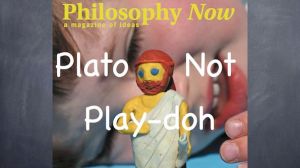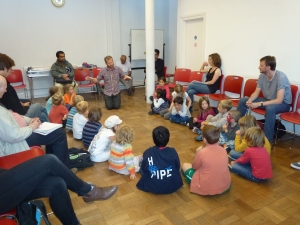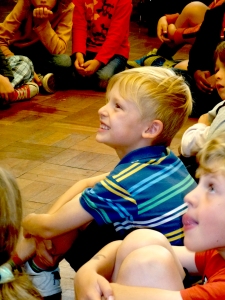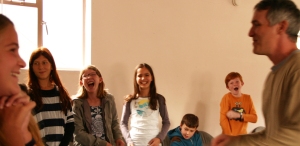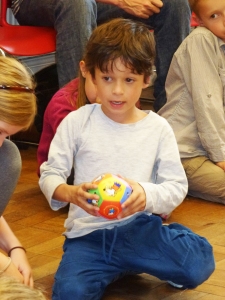So you want to set up a philosophy club for your child or children.
What is philosophy and why do it?
This is a big question and not easily answered but I’m going try to give a snappy response – snappy for a philosopher anyway.
A good place to start is that philosophy is about thinking. Next, we might say that it is thinking about thoughts and thinking itself (but not how a psychologist does). Here’s a bit more: inspired by the ancient Greeks, philosophy can be said to be a rational attempt to better understand ourselves, the world and our place in it. Philosophy’s main questions can be broken down to these four:
1) What is there? (Reality or metaphysics)
2) What can be known about what there is? (Knowledge or epistemology)
3) What matters in what there is? (Value or ethics/politics/aesthetics)
4) What can be said about what there is? (Logic, language and meaning)
Philosophy also has certain characteristics that I have tried to capture in the 4 Rs of philosophy (for more on this see my TEDx talk, Plato not Play-doh):
Response: first of all there has to be something that is puzzling and this is often accompanied by a pre-reflective, intuitive response (E.g. ‘That’s not fair because he’s not sharing!’)
Reflect: then there is a ‘standing back’, a reflection, often of the form ‘What is X?’ (E.g. ‘Hang on, what exactly is fairness?’)
Reason: Then there is an attempt to answer the reflective question through a process of reasoning (E.g. ‘So, fairness is… because…’)
Re-evaluate: and finally there is the all-important and ever-present further reflection upon the reasoning. (E.g. ‘But is that right? Because, actually…’)
The relationship between reasoning and re-evaluation is what makes philosophy, in my view, fundamentally dialogic – in other words, a kind of conversation, either with others or oneself.
Often, at some point, a judgement is made, but the judgement is only ever provisional because of the ever-present re-evaluation rule. The good outcomes, or added value, of doing philosophy are that there might well be clarity, insight, or, a certain smaller problem within ‘the big problem’ may even get solved. In which case there might be a fifth R: Resolve?
When doing philosophy with children the emphasis is on the ‘doing’. So, they will not be learning about philosophy (the ‘who-said-what-and-when’) – and this should be reassuring if you don’t know much about it anyway. Instead, they will philosophize with each other. For this, they already have everything they need to begin (a brain, ears and a mouth). However, it’s up to you to make sure the conditions are right for them to be able to begin.
For more on ‘Why do philosophy in schools?’ go here:
‘The First R’
‘If understanding and wellbeing are central to education then philosophy must be taught in schools.’
‘Class Act’
Who’s it for?
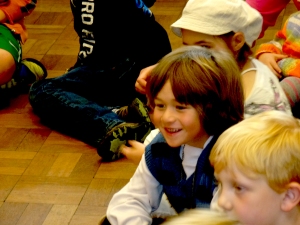 Your child, obviously. But there should be others too as this is going to be discussion-based. Try to find children who want to be there, although, this will, to some extent, be down to how fun and interesting you can make it.
Your child, obviously. But there should be others too as this is going to be discussion-based. Try to find children who want to be there, although, this will, to some extent, be down to how fun and interesting you can make it.
So, how many then?
Remember that it is very difficult to sustain a philosophical discussion with just one or two children because children don’t usually have a sufficient diversity of ideas to keep a philosophical discussion going. A group of children is much more likely to have the necessary diversity of ideas. So, I recommend a group of no less than 8 children and probably not much more than 18. 12 would be perfect (this is just a guideline so it could be amended depending on the children attending).
Where?
Find a place with lots of space. You may just need to push a few things out of the way to get the space you need in a front room, for example. If there is a larger space available to you then try to use that but it should not be too large as discussion is difficult in echoey places such as church halls.
How should I set things up?
Set up some chairs to form a horseshoe shape and, if possible, have a flipchart, some different coloured pens and a pile of A4 paper.
When?
One day-a-week after school is probably the best time. Otherwise, a Saturday morning could be good. Anytime that’s convenient for all is likely to be the time you fun The Philosophy Club.
How long?
Usually an hour is a good time for philosophy, however, getting them to sit and discuss for a full hour is going to be tough, especially after school when they could be doing something more fun. So, here’s my recommendation for how to divide up the hour:
First 15-20 minutes:
Assuming that they won’t all turn up on time have some thinking games ready that they can play in pairs, threes or fours as they come in. See Robert Fisher’s Games For Thinking for some ideas. I would have little strategy games ready like Nim (and its many variations), Fifteen etc. See Fisher’s book and The Philosophy Foundation website for how to play these (and other) games. You will need more props for these games such as a deck of cards or two, beads or pebbles etc.
Middle 35 minutes:
Use this for the PhiE (philosophical enquiry), which should follow this procedure (NB: the philosophy is not the procedure described below; the philosophy happens in good quality dialogue around philosophical topics, the procedure is there merely to try to create the best conditions to allow philosophy to happen):
1) Present the stimulus (story, scenario, puzzle, activity etc. see resources below) and ask the Task of Start Question (see The If Machine and/or The Philosophy Shop for explanations of these).
2) Give children Talk Time – 1 or 2 minutes of time to discuss the question with a partner.
3) Show sign to begin discussion – see Stop Look and Listen Rule below in ‘Rules for the group’.
4) 2-5 minutes of discussion (Try to identify diversity by asking for a ‘Yes’-response to the question, a ‘No’-response and a ‘something else’-response such as ‘yes and no’, ‘I don’t know’ and so on. This helps to bring the controversies out. Also see imaginary disagreer below.)
5) More Talk Time – it’s always good to give them more time to talk with each other once a greater diversity of ideas has been voiced. There’s more to talk about then.
6) Return to group discussion – let them explore different ideas first (‘I think X…’) and then they can move to justifying them (‘So, does everyone agree with all the ideas we’ve heard?’)
7) Move between discussion and Talk Time as many times as necessary or until the 35 minutes elapses.
Ending 10 minutes:
Play a game to end with that involves the whole group and which will get them standing up. The following games are favourites of The Philosophy Foundation and can be found on our members website, which is free to join: Twenty-One, Random Words, Samurai, Bippity-Bippity-Bop and The Sitting Down Game.
Snacks:
It’s always a good idea to bribe children with snacks! However, I recommend leaving the snacks to the end or you’re likely to have a major sugar-rush problem on your hands for the next hour!
Rules for the group (the children):
• Speak one at a time (I use a ball that I pass to speakers to make this visual). – The Ball Rule
• Listen to whoever is speaking. – The Listening Rule
• Hands up if you want to speak; hands down when someone else is speaking. – The Hand Up/Hands Down Rule
• Respect each other (usually: don’t be rude, don’t make fun of and don’t laugh at others’ ideas – unless it’s a joke of course!) – The Respect Rule
• They should know that they are free to disagree with each other as long as they do so with respectful language. – The Free-to-disagree Rule
• They are to stop, look and listen immediately when the facilitator holds the ball in the air. – The Stop Look Listen Rule
• Those that persistently break the rules will be asked to leave The Philosophy Club.
Rules for the facilitator:
• Shut up! – you must not say what you think about the issue. Don’t get involved. Ask another adult to listen in to see if you’re sticking to the rule (and the other rules, for that matter).
• Listen! – always make sure you are actively listening (listening to understand).
• Question! – question in order to understand (this follows on from the listen! Rule) The main ‘opening-up’ questions you will ask should be:
o Justification (E.g. ‘Would you like to tell me why?’)
o Elicitation (E.g. ‘Can you say more about that?’)
o Clarification (E.g. ‘Can you say what you mean by?’)
o Exemplification/counter-exemplification (‘Can you give an example?’ / ‘Can anyone think of an example where not X?’)
• Enthuse! – be enthusiastic and show interest in their ideas while remaining neutral.
• Allow time! – don’t rush them or ask too many questions; one clear question and time-to-think is all they will probably need.
• Encourage peer conversation – don’t have conversations with the children; get them having conversations with each other.
• Use ‘the imaginary disagreer’ (see below), not devil’s advocate moves, or else you’ll be doing the thinking for them.
• Echo what they say – if you say anything at all; don’t paraphrase (‘So, you’re saying…’) or interpret (‘So, what you mean is…’) what they’ve said.
• Don’t answer questions that children ask; get the group to do that.
• Use closed questions (‘Is the mind the same as the brain?’) but remember to ‘open them up’ (see the list under the Question! Rule).
• Draw out controversies/tensions (but they must see controversies for themselves!) You should be: providing the conditions for the children to see, for themselves, philosophical controversies for them to then try to solve.
A useful classroom technique: the Imaginary disagreer
This is where, when you want to introduce an alternative position that the children may not have thought of, you activate them to do so instead of doing it yourself with the usual ‘devil’s advocate moves’. This is how you do it. When necessary or appropriate simply ask: ‘What do you think someone would say if they disagreed with you?’ and then follow this up with: ‘What reasons do you think they might have for thinking that?’ Have this strategy ready to help the group create it’s own diversity and thereby create it’s own controversies. Usually the children will be motivated to think of contrary ideas to those of their peers but if/when this doesn’t happen then use ‘the imaginary disagreer’ – he/she can be very useful.
Last Word: at The Philosophy Foundation, when philosophy with children is done formally in an educational setting, because of the special educational aims and objectives, we usually recommend that philosophy facilitators be philosophers (that is: have studied philosophy). But in a more relaxed atmosphere such as a parent-run philosophy club, where the main aim is to be social and fun as much as intellectually stimulating, a background in philosophy is of less importance. That said, it will not harm to read up on dialogue facilitation and philosophy (see resources). Listen! keep an open, inquiring mind, and remember to have fun and to make it fun!
What resources should I use?
Games For Thinking (Games) **
The If Machine (Guidance and lessons) **
The Philosophy Shop (Guidance and lessons)
Plato Was Wrong! (Secondary/late primary)
Philosophy For Young Children (Early Years)
Provocations (Secondary/late Prep)
Once Upon an If (For storytelling skills and ideas)
What Makes Me Me (BBC films resource)
Big Questions (films made by The Philosophy Club)
Online article: Socratic Irony in the classroom
Online article from Creative Teaching and Learning magazine: The Question X
If you only have money for one or two books then go to ** to get started.
We recommend the following websites and podcasts to learn more about philosophy:
History of Philosophy Without Any Gaps
Join our website and see sessions modelled.
Listen to Philosophy Now podcast of children doing philosophy and this blog that accompanies it.
Books for the children to read in between Philosophy Club days:
The Philosophy Files
The Philosophy Gym
Thoughtings
See more books for young people on our resources pages
The blog was originally written for the Parents Show and Keystone Workshops.

